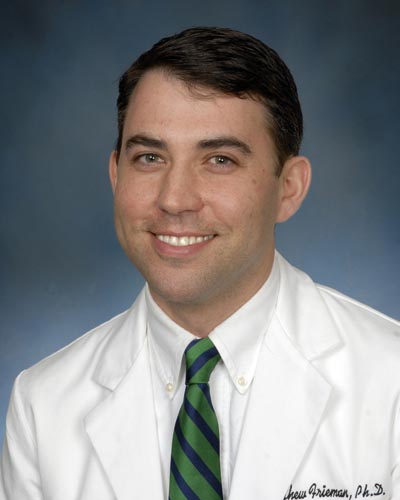March 22, 2018 | David Kohn

University Of Maryland School Of Medicine Scientists Target Bacteria Involved In Chronic Obstructive Pulmonary Disease
Every year, approximately 12 million adults in the U.S. are diagnosed with Chronic Obstructive Pulmonary Disease (COPD), and 120,000 die from it. For people with COPD, Haemophilus influenzae, a bacterium, can be particularly dangerous.
The microbe can reside in their lungs and wreak havoc within already weakened organs. Identifying the genetic variations of this microbe is vital to treating these patients effectively.
Now, a University of Maryland School of Medicine (UMSOM) researcher teamed up with researchers at the University of Buffalo and Yale University to better understand how the bacterium adapts quickly, which may open new avenues for therapy for COPD patients. The new findings, which relied on genomic analysis, may also be useful for people who have other diseases such as ear infections or pneumonia, since this microbe can cause these diseases as well.
The research was published today in the Proceedings of the National Academy of Sciences.
“The question we asked was why are certain strains of the bacterium are so much more dangerous than others. We discovered a genetic pattern, which helps explain why certain strains are so virulent,” said Hervé Tettelin, PhD, associate professor of microbiology and immunology and member of the Institute for Genome Sciences (IGS) at UMSOM. “This offers key clues about what this microbe does to evolve in the lungs of people with COPD, and it may open exciting new avenues for treatments and vaccines for the future.” Dr. Tettelin oversaw the genomic data mining with the isolates.
He collaborated with Timothy Murphy, MD, senior associate dean for clinical and translational research and professor at the University at Buffalo Jacobs School of Medicine and Melinda Pettigrew, PhD, senior associate dean for academic affairs and a professor of epidemiology at the Yale School of Public Health. Over 20 years, Dr. Murphy has collected thousands of strains from COPD patients.
Some strains of the bacteria are more dangerous than others. The level of lethality depends in part on which genes get turned on, and which are turned off. Certain patterns allow the bacteria to adapt more efficiently to the lungs, allowing it to cause more damage.
With data mining, the researchers detected certain patterns of genetic activation or inactivation. With this information, the researchers say they may be able to develop new treatments and new vaccines. “We now have a much better understanding of how certain strains of the bacterium adapt to the lungs,” said Dr. Murphy.
The team studied the genomic isolates from distinct time periods: what the isolates look like when Haemophilus is acquired by a patient, and how they look when they’re about to be cleared out of the lungs. The researchers learned that there is evidence of adaptation. H. influenzae uses mechanisms to vary its genome and the proteins it uses to interact with the host.
Interestingly, much of the variation appears to be random. In the bacterium, a subset of genes are randomly turning off and on constantly. Some of these mutations are useful to the microbe, while some are not. Those that work are conserved, while those that fail do not survive. Essentially, the bacterium undergoes a constant state of evolution.
These findings are important for vaccine researchers. This kind of data mining helps researchers more precisely identify better vaccine candidates, which can lead to better treatments for COPD patients.
“In recent years, data mining has become an integral part of medical research,” said E. Albert Reece, MD, PhD, MBA, Executive Vice President for Medical Affairs at UM Baltimore, and the John Z. and Akiko K. Bowers Distinguished Professor and Dean, University of Maryland School of Medicine. “This new paper opens up exciting new avenues for COPD research, and could eventually enable us to come to a better understanding of the complex ways in which microbes interact with the lungs.”
James Munro, PhD, Bioinformatics Analyst at IGS, and Adonis D’Mello, a graduate student in molecular medicine, also contributed to the research.
About the Institute for Genome Sciences
The Institute for Genome Sciences, founded in 2007, is an international research center within the University of Maryland School of Medicine. Comprised of an interdisciplinary, multidepartment team of investigators, the Institute uses the powerful tools of genomics and bioinformatics to understand genome function in health and disease, to study molecular and cellular networks in a variety of model systems, and to generate data and bioinformatics resources of value to the international scientific community. igs.umaryland.edu
About the University of Maryland School of Medicine
Commemorating its 210th Anniversary, the University of Maryland School of Medicine was chartered in 1807 as the first public medical school in the United States. It continues today as one of the fastest growing, top-tier biomedical research enterprises in the world -- with 43 academic departments, centers, institutes, and programs; and a faculty of more than 3,000 physicians, scientists, and allied health professionals, including members of the National Academy of Medicine and the National Academy of Sciences, and a distinguished recipient of the Albert E. Lasker Award in Medical Research. With an operating budget of more than $1 billion, the School of Medicine works closely in partnership with the University of Maryland Medical Center and Medical System to provide research-intensive, academic and clinically-based care for more than 1.2 million patients each year. The School has over 2,500 students, residents, and fellows, and nearly $450 million in extramural funding, with most of its academic departments highly ranked among all medical schools in the nation in research funding. As one of the seven professional schools that make up the University of Maryland Baltimore campus, the School of Medicine has a total workforce of nearly 7,000 individuals. The combined School and Medical System (“University of Maryland Medicine”) has an annual budget of nearly $6 billion and an economic impact in excess of $15 billion on the state and local community. The School of Medicine faculty, which ranks as the 8th-highest public medical school in research productivity, is an innovator in translational medicine, with 600 active patents and 24 start-up companies. The School works locally, nationally, and globally, with research and treatment facilities in 36 countries around the world. Visit medschool.umaryland.edu/
Contact
Office of Public Affairs
655 West Baltimore Street
Bressler Research Building 14-002
Baltimore, Maryland 21201-1559
Contact Media Relations
(410) 706-5260
Related stories

Wednesday, December 16, 2020
University of Maryland School of Medicine Researchers Create Extensive Gene Expression Database to Gain New Insights into Pneumococcal Infections
Researchers at the University of Maryland School of Medicine published one of the most comprehensive analyses of how genes get expressed during infection (known as a transcriptome). The analyses include three different strains of the bacteria Streptococcus pneumoniae, which causes pneumonia, meningitis and middle-ear infections. It also includes analyses of the lungs and four other organs in an animal model where the bacteria resides, multiplies and takes hold in the body. Their findings were published today in the Proceedings of the National Academy of Sciences.

Friday, October 18, 2019
Diabetes Worsens Respiratory Illness Due to Abnormal Immune Response, UM School of Medicine Study Finds
Since the Middle East respiratory syndrome coronavirus (MERS-CoV) first emerged in Saudi Arabia in 2012, there have been more than 2,400 confirmed cases of the infection, resulting in greater than 800 deaths – an alarming fatality rate of 35 percent. For this reason, researchers have been eager to identify any risk factors that contribute to the development of severe or lethal disease. Current clinical evidence points to diabetes as a major risk factor in addition to other comorbidities including kidney disease, heart disease, and lung disease.

Tuesday, August 13, 2019
Researchers Identify How Vaginal Microbiome Can Elicit Resistance or Susceptibility to Chlamydia
The vaginal microbiome is believed to protect women against Chlamydia trachomatis, the etiological agent of the most prevalent sexually transmitted infections (STIs) in developed countries. New research by the University of Maryland School of Medicine (UMSOM) shows how the microbiome can either protect or make a woman more susceptible to these serious infections.

Friday, September 14, 2018
Nationwide Research on African-American Kidneys Hopes to Unravel Genetic Variation That Increases Disease Risk
With African-Americans developing kidney failure at rates four to five times higher than Americans of European descent, a groundbreaking nationwide study will track nearly every African-American donor kidney over the next five years.

Tuesday, December 19, 2017
UMSOM Scientists Identify Key Factors that Help Microbes Thrive in Harsh Environments
Three new studies by University of Maryland School of Medicine (UMSOM) scientists have identified key factors that help microbes survive in harsh environments.
